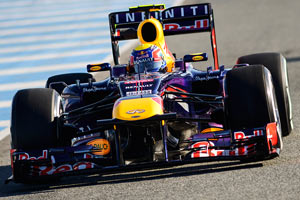dren wrote:So why wasn't the Lotus car spanking the competition too?
'They were spanking the competition. The car was the second best car over the whole season.
If you notice their tyre wear, it was a good indication that the car wasn't running to 100% of it's potential.
Also take into consideration the consistency of the car in the stints and also the manner in which they went about a race with their strategy. That car was at half mast just like the redbull when it came to setup for qualifying and race.
Romain Grosjean proved that all it took was suspension geometry change to unlock the car, and it became sure podium grabber. Beating webber to the podium most of the time, in the steady manner that it drove also shows the strength of the desing.
I witnessed Lotus spaking everybody this season when it came to consistently fast pace. Take redbull out of the equation and you have the season's best car. The weakness was more to do with the team strategy and the drivers.
But back to the subject, just so that people understand what i'm getting at fully. The arc is used completely along the length of the car. It's not 4 or 5 arcs forming a line on the side pod. It's one consistent curve terminating to the floor or gearbox area. This has only been used in the redbull cars. How I know this? because we all have eyes to see. It doesn't exist in any car, no matter how far you want to look back in history. Find a car and I'll show the design philosophy is not there.
This is not common knowledge. I don't thing F1 engineers are god's or geniuses. I was hit with the same "f1 eng are smart, the tried it already" when I suggested that pullrod suspension is a no brainer. We need to move beyond that kind of thinking. Only gods have thought of every possibility.

a rb car would have sufficed but this gives more clarity for the lines. Notice a constant curvature defining the shape.

I also learned that there is a strong relationship with the top and sides, and if there is poor transition between both then the pressure zones are quite messy and downforce creation is poor. This is why the sauber sidepods have failed to realize it's intention. The goal is to have the taper of the top very much mirrored by the taper of the sides. This way you don't have much speed differentials with the top and bottom, hence "ugly" pressure distribution.
As said earlier big things make bigger impacts aerodynamically. A little vortex generator doesn't do much. It only improves areas of bad flow, like behind the wheels. or behind a wing. It mainly puts energy in low energy areas.
The sidepod and engine cover was the elephant in the room, no one cared to look into. The body of the car has the greatest surface area, even more than the wings. And we all know the basic aero equation has downforce directly proportional to area. Improving a major area gives greater improvement in downforce. Returning a 10% improvement in the body alone is a very healthy dose of downforce.
The arc also plays into why redbull can rake the car and still have so much stability. Rotating a circle doesn't change it's aerodynamic behaviour. If you have a piece of a circle as your sidepod, rotating it doesn't change it's behaviour as well.
So stability is another hallmark. They can turn the rake up all the way till the nose rubs the ground, and get secondary benefits from the front wing and diffuser. So you see how this is all tied in.









